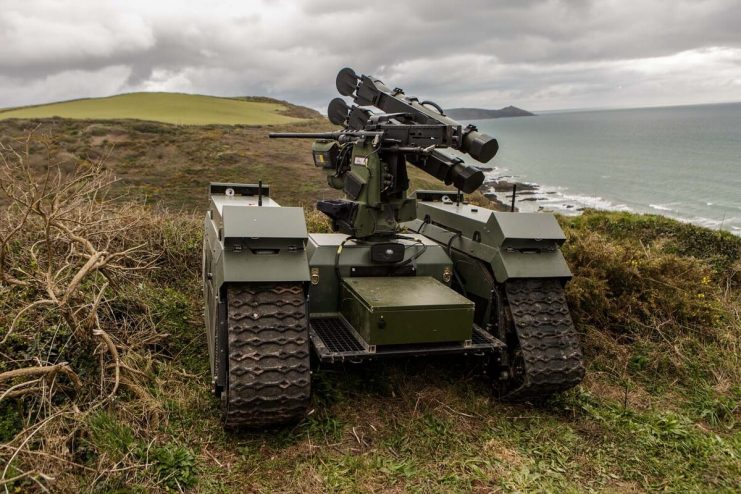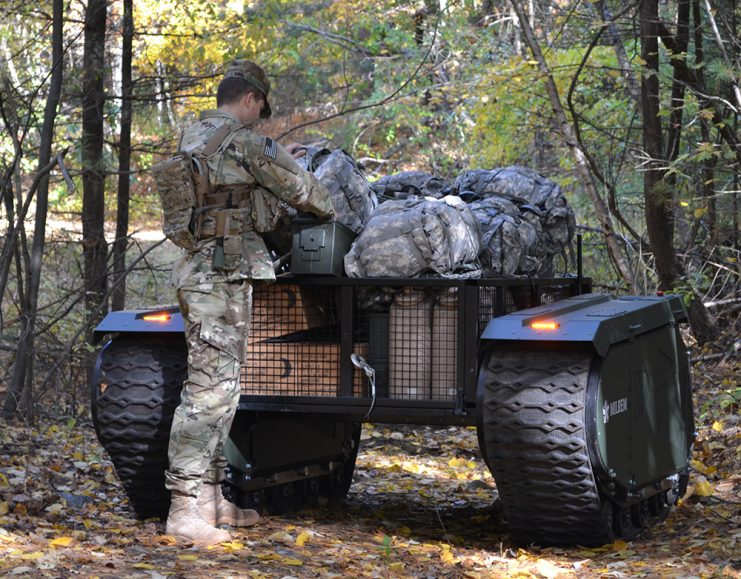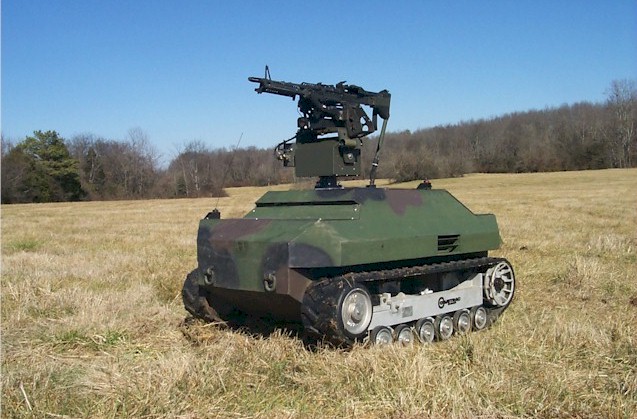Robots on the battlefield – in April 2019, for the first time, armed robotic vehicles were part of a British Royal Marines war game assault.
The war game, part of a larger training called Exercise Commando Warrior, was no ordinary drill. As the Alpha Company of the Royal Marines 40 Commando unit captured and secured a Cornwall area beach in southwest England, they had special robot support on the land, sea, and air.
A robotic boat, which is an unmanned vehicle, circled along the coastline searching for enemy forces in the water and on land. It was able to do this using special sensors and cameras.

Another unmanned device was flying high in the skies above the Royal Marine assault group. The drone-like aircraft surveilled and monitored the area for enemy forces and signs of danger.
Robots
But the newest and most exciting addition was the unmanned ground vehicle robot often referred to as a UGV. About the size of a jeep, the ground robot was used for overwatch and boosting firepower capabilities. It was mounted with heavy machine guns and rockets.
The UGV was a QinetiQ North America and Milrem Robotics Titan with tank-type tracks on the bottom.
The Titan is unique because it is both modular and a hybrid unmanned ground vehicle. According to QinetiQ’s website, the modular design enables various types of superstructures to be secured onto the vehicle platform.
As a result, the equipment and arming that can be mounted on the Titan can be easily interchanged for a variety of different missions, from rescue and transport to reconnaissance and firepower support for “small military dismounted operations.”
Using the Titan means that soldiers can stay safe while the robot takes out targets and supports other ground troop activity. The UGV can also support anti-tank Javelin missiles.
The robotic boat, aircraft, and the UGV used in Exercise Commando Warrior are also used to gather data. The data is then communicated back to human teams who review the information on hand-held tablets from the safety of their command headquarters.
They also monitor how the robotic vehicles respond to the challenges, look for any issues, and consider how best to modify the vehicles further looks like robots are here to stay.

Other countries are also developing and testing unmanned ground vehicles for their military forces. For example, in 2017, the U.S. Army began looking for a robot or robotic armored vehicles to replace the manned M2 Bradley assault vehicles.
Armored M113 vehicles with tank-like tracks have been used in training exercises to provide cover fire for soldiers. The M113 are mounted with remote-controlled machine guns, and the vehicle can be manned or unmanned. A command vehicle follows behind with communication links to the remote-controlled M113.
The Russian army has also been working on developing tactics and designs for unmanned vehicles. A ground robot called the Marker is the size of a tank and has tracks on the bottom. Like the Titan, Marker is modular.
Russia has used Marker in training exercises in which humans and robot scout forces relay information back to the main force of drone vehicles similar to tanks. It can support multiple weapons configurations, such as anti-tank grenade launchers and machine guns.
In addition to the focus on unmanned ground vehicles, the United Kingdom has also been working on its air and underwater robotic vehicles.
The United Kingdom reintroduced the Black Hornet for aerial scout capabilities. The Black Hornet is the size of a human palm and is used for basic covert scouting and reconnaissance functions.
The U.K. Ministry of Defense also announced in April 2019 that it was beginning a $3.3 million competition for the development of a large, robotic submarine.
As the post-Cold War era submarines continue to fall out of use, they will be phased out and will be replaced with newer non-nuclear reactor-powered submarines, including a complement of unmanned submarines.
The United States is also looking to replace its nuclear submarines with unmanned robotic submarines.
Robots & Subs, the robotic submarines could be used for underwater surveillance and traffic monitoring, anti-submarine warfare, mine countermeasures, anti-surface warfare, electronic warfare, and strike missions. They can also spend more time deployed hunting enemy ships.
As nations continue to address soldier safety, monetary concerns, and keeping up with allies and foes, it appears that robotic vehicles will continue to be of great importance in the military of the future.
Another Story From Us: Some of the Best Anti Tank Rifles
